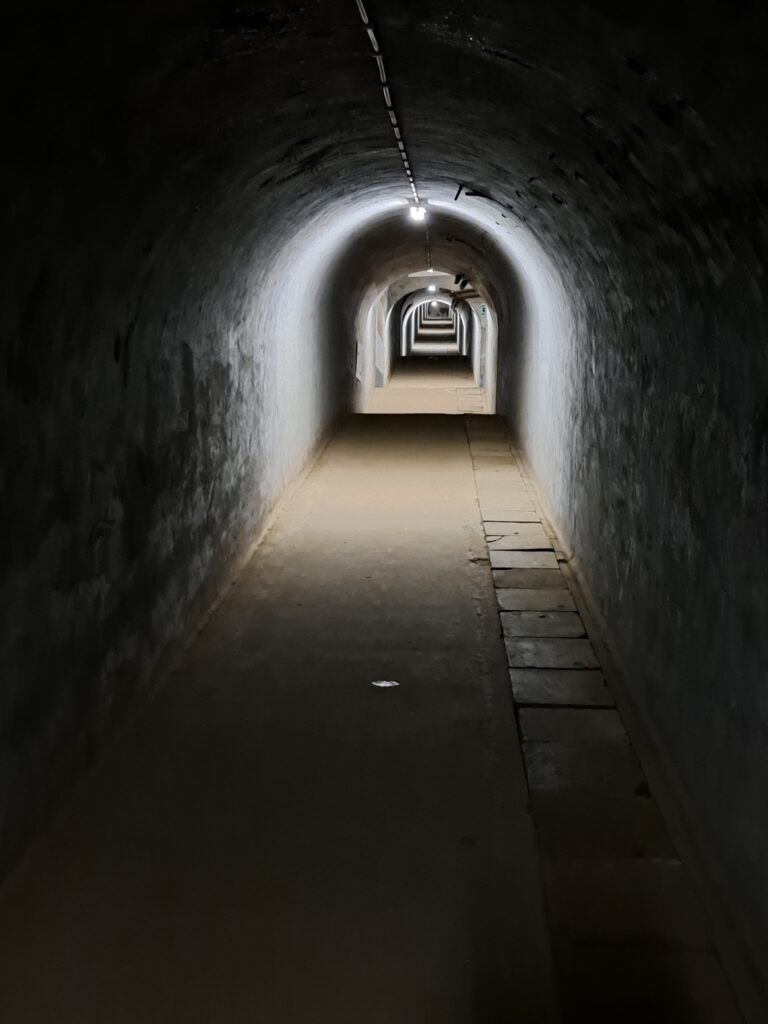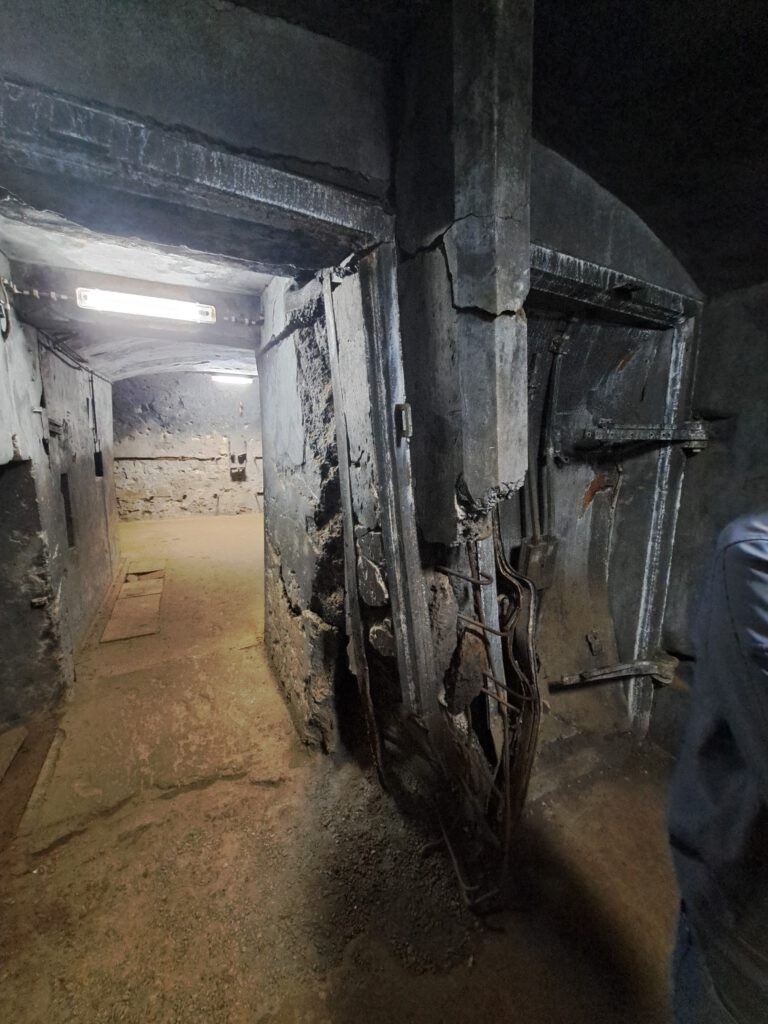The fortress Eben–Emael is located near Maastricht and the village of Eben–Emael in Belgium and was part of the fortress belt around Liège.
After the First World War, the Belgian government decided to build a previously missing defence work between the Albert Canal, the Meuse and the Ardennes. Due to the economic malaise, no money had been made available until then for the construction of a fort that had to fill a hole in the fort belt. The project was also started to provide work to the many unemployed workers in the economically difficult time. Belgium made a reservation of 24 million Belgian francs to build the fort and the major work was started on 1 April 1932 and was completed in 1935. The further set-up continued until May 1940 and was actually not quite finished when the attack of the Germans took place.
The fort became the central point of the Belgian defense on the eastern border and served to guard the three bridges over the Albert Canal, near Vroenhoven, Veldwezelt and Kanne. The fort was built in three layers. The underground barracks at the lowest level, then the 20 meter higher casemates and ammunition warehouses and 40 meters above the gun bunkers with two ammunition lifts. The top floor of the gun domes was a 360 degree circular battle tower, executed as an armored cylinder. The fort was staffed by two teams of 600 men, relaying each other every other week. All batteries had one or two anti-tank cannons of 60mm, machine guns and floodlights as armaments. The anti-aircraft defence on top of the fort consisted of four Vickers aerial machine guns. Ironic fact afterwards, initially they wanted to use heavier cannons with a larger scope. These cannons could then in principle affect Aachen in Germany and that could be understood by the Germans as violating the Belgian neutrality attitude! The arming of the fort was superior for that time, even with the 60mm cannons, and the fort was therefore described as impenetrable.

How different, however, was reality. The objectives war from the First World War was replaced by the war of movement by the Germans. It would soon turn out that the fort was very well equipped to turn an attack over land. What was not thought of was that the war strategy would now use new techniques such as gliders and smart ammunition with a hollow load, especially suitable for striking large gaps in the steel defense. It can be seen that a fortress like Eben–Emael is about 20 years behind the new technique of the enemy. Modern warfare with aircraft and quickly moveable vehicles (Einsatz naturer Angriffsmittel), made the static fortifications useless and unnecessary.
On 10 and 11 May 1940, Belgium was still neutral and was not prepared to be involved in the Blitzkrieg, the fortress was deactivated by the Germans in 1.5 days. Two of the three bridges to be defended also fell into the hands of the Germans without a fight, who were therefore able to continue the rapid advance.

With a strategy, developed by General Kurt Student, on May 10, 1940, around 3:30 a.m. 11 transport aircraft and 11 gliders (type DFS 230) depart from airports near Cologne towards the fort. After releasing the gliders, they must quietly approach and attack the fort. Nine of the eleven aircraft land around 4:20 a.m. on the above plateau, 15 hectares in size, only partly defended by 2 machine guns and two-dome grenades, which turns out to be perfectly suited for this surprise attack. The landing takes place a few minutes before the German declaration of war. It is the first attack with gliders in history (later, in the attack on the Normandy coast, John Howard (British 6th Airborne division), also with gliders, will show the same piece of art by landing just a few meters from the bridge at Bénoville (Pagasus bridge) and taking the bridge directly). The attackers have a new extremely strong explosive, the hollow charge, a kind of jumping charge. In fifteen minutes, the objects to be destroyed will be neutralized. A number of counter-attacks to stop the attack fail. On the night of 10 to 11 May, German ground troops cross the Albert Canal and surround the fort. In the morning of May 11, the attackers detonate hollow loads in various places. The impact of these explosions is so great that the commander of the fort decides to surrender the fort after 32 hours. There are 24 deaths and 62 Belgian wounded. German victims: 6 dead and 20 injured. The shutdown of the fort gave a decisive turn to the newly started war on the Western Front.

The Germans were very well prepared. Information was collected via aerial photographs and it was also found that a German contractor was involved in the construction of the fort that could transfer a lot of knowledge about the construction of the fort. There was practice at Hildesheim in Germany and in Poland on the Czech line of defense. Through aerial photographs, a scale model of the fort was made and there was still practice on a site near Stolberg that was very similar to that of Eben–Emael. The training of the German Fallschirmjäger who would participate in the attack was excellent. The group that was to carry out the attack lived isolated from November 1939. The name of the target remained secret from the attackers until May 10, 1940.
The rapid gathering of the fort had several causes. As already mentioned, the fort was not quite ready and Belgium was not prepared to be sucked in the Second World War. The crew of the fort was not (yet) trained to resist the attack of the Germans. Many functions of the fort did not work at the critical moment, ammunition lifts that did not function, telephones that did not work. Also the the lack of ammunition and the lack of motivation in (part of) the crew of the fort (low morale), did not improve the situation. The relationship between the officers and the soldiers left was far from ideal and also the stay in the fort was significantly better for the officers than the small space in which 60 soldiers had to stay.
A critical moment of the attack was the discovery of the gliders. The planes had no signs on the fuselage and the army leadership of the fort did not order shooting. They first wanted to determine what kind of aircraft it was exactly. If one had immediately taken action, the result of the attack would have been completely different. Now the gliders were already on the plateau at the time the order was given.
Due to the rapid shutdown of the fort and the two bridges still intact over the Albert Canal, the German advance towards the French coast was accelerated and the Battle of France (Fall Gelb and Fall Rot) was finished on 22 June 1940 and surrendered France, completely enclosing the British expeditionary army at Calais.
At the liberation of Maastricht on September 10, 1944, the fortress was effortlessly taken by the American 30th Infantry Division (Old Hickory). The fort served as a storage place for the Belgian army. In 1987, the fort was given the status of a privileged monument.

To reflect the atmosphere at the fort, below is part of the report of one of the Belgian Air Defense soldiers:
“At 00.30 we are woken by the chief of the guard post, who informs us of the reception of the real alarm order. But we don’t believe him. We have been given that dirty game so many times. We get up and wait for instructions. The commander arrives a little later and speaks to us, in his usual way as with his children and says “now it really is war”. The 20 cannon shots convince us more than anything else. We must be ready, but we do not have to occupy our positions on the massif until later. By 04:00 we will occupy our positions. We hear the sound of an engine from an aircraft in the direction of the north point. The observers tell that there are planes coming from the direction of England. The vision is not yet clear, we can not see anything ourselves. A little later when the sun rises, we hear noise in the sky. We are all in our trenches while the noise is getting closer and closer. Suddenly we see planes above us in the air that we cannot identify. We immediately warn the command post, but twice we are answered that we are only allowed to shoot when we are sure of their nationality. The minutes pass and the gliders descend quietly, without any resistance. Our fingers are itching to pull the trigger. Without waiting for the assignment, our adjutant will decide to open fire. But it is in vain, several gliders literally dive down on us and we are surrounded. The gliders are hardly grounded yet, or the doors are thrown open and the occupants jump out of their aircraft and bombard us with a hellish fire of automatic weapons and grenades. Miraculously, equally in number, but otherwise armed, our opponent has the force majeure. Our air defence machine guns and our carbines are no longer useful, everything that rises above the trenches is an ideal target for our opponent and we did not have any hand grenades. They would later be delivered to us with our food. Our machine guns came from the previous war and do not meet the demands for such an attack. When our attackers saw it, they mocked and laughed at our outdated material.”
Source:
Ceux du Fort d’Eben-Emael – The Committee of the Amicale
Various Wikipedia articles